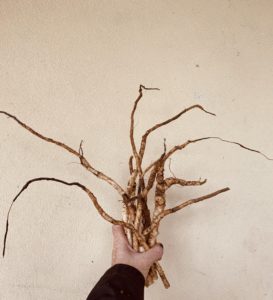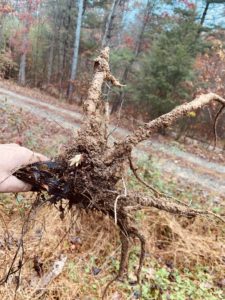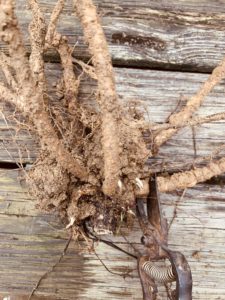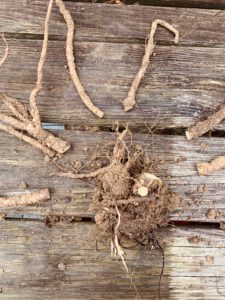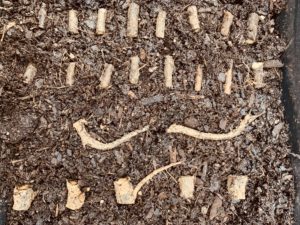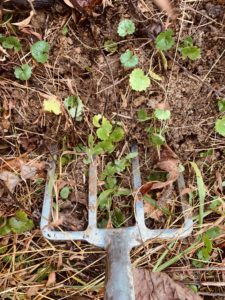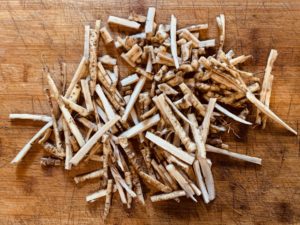By Greta Dietrich
In the southeastern United States, November is the time when we begin to gather the root medicine from our perennial allies. Midway through fall, as the days shorten and the weather becomes colder, first freezes die back the terrestrial parts of plants. After the living green dies away the energy of a plant flows into the underground organ we call the root or rhizome. Starches and carbohydrates and many other chemical components gather in a concentration in the root acting like a battery to assist the plant through the winter and ensure new growth in the spring.
There are optimal times throughout the year for harvesting all parts of the plant – the flowers, leaves, buds, seeds and roots. Some plants require several seasons to pass before they are ready for harvesting roots. Echinacea, purpurea for example, needs to have three years of growth, and Astragalus, membranaceus needs four to five years of growth. Only after these plants have had many seasonal cycles will their root medicine be ready. This is mostly because it takes several years for the roots to develop into large enough size and build up a concentration of medicinal constituents.
Deciding the best way to harvest a root is unique to the plant. Before harvesting, take into consideration if the plant that you have positively identified is native or a non-native species. Non-native are more sustainable to harvest because often they are more invasive and are endangering native species. If it is a native species check to see if it is an at risk plant. United Plant Savers is a great resource for educating yourself on endangered plant species.
Instead of wildcrafting native species, search out your local woodland farmers and support them. Do not harvest anything that is endangered or at risk.
After answering these questions for yourself, then decide if you should partially harvest a root, fully harvest it or leave it alone. A partial root harvest allows for some of the root to be harvested and replanted with the intention that the plant will continue to grow for years, creating a more sustainable relationship. This may be a great option for a plant you are trying to establish a large patch of and don’t want to cut into the population such as black cohosh (Caulophyllum thalictroides) or wild yam (Dioscorea villosa).
As an example, one can harvest part of a comfrey root and replant the rest. Comfrey (Symphytum officionalis), is easy to propagate from root. Half of the harvested root can be used to propagate new comfrey plants and used to replant in my garden, the remainder I will dry and use for salves.
If I treat 6-7 comfrey plants like this I can get a good amount of medicine and a plethora of new roots for vegetative propagation for the following year. Deciding whether or not to harvest a whole root as opposed to partial root harvest depends on what your need is. Either way, inspecting the root when harvesting gives opportunity to make root divisions and stimulate new growth come spring. Harvest half to three-fourths of the root system for medicine and replant the remaining roots attached to the crown (see figure 3 & 4).
By digging the root and separating the rootlets and buds and cutting up the root you can make clones of the root stock and enlarge your stand of that particular plant. Depending on the plant you could get anywhere between 7-20 baby plants or divisions off of a mother plant (see figure 5). The benefit of this is that you can bypass the process of seed starting which has many processes such as the time it takes to create mature plants. Planting from division you get the same characteristics as the parent. This is a great way to work with genetic qualities you favor and characteristics you like in a plant.
Take extra care to properly identify the plant before harvesting. The lack of foliage may prove difficult to identify. Roots tend to overlap and inter-grow. Once I had a very well-meaning forager bring me a nice harvest of Japanese knotweed. The patch of plants had been properly identified and I happily set to work processing the freshly harvested roots. While cleaning tiny little rootlets that were growing in and around the main root system, little did i know i was removing poison ivy roots with my bare hands, which 48 hours later showed up as the worst poison ivy rash of my life. It is wise to follow a plant through several seasons for this reason to properly identify it. If this had been done with the knotweed, then certainly the jolly forager would have known poison ivy also grows in this patch with the knotweed.
Another thing to keep in mind is where you are harvesting. Steer clear of roadsides and around houses or fence lines where the ground may have been sprayed with harmful chemicals. If you decide to do a whole root harvest, then the plant obviously will not be growing the following year. This may be fine especially if the plant is an invasive species in your planting zone like japanese knotweed or kudzu root, or if you simply want to thin out an overcrowded area in your garden.
A digging fork is a great tool to use for harvesting roots. Use the sturdy tines to create a circle around the plant you wish to unearth. By gently rocking the digging fork back and forth around the base of the plant or root crown you can begin to loosen the root and get a sense of how deep it is and if there are any lateral roots. Stopping and using your hands to get a feel for how and in what direction the root is positioned is helpful.
As soon as you have harvested the roots , you will want to process them as soon as you can. Using a hose and a brush is very helpful in removing soil. I always have pruners handy to break up bigger sections and scissors to break up smaller sections. As soon as all roots are well cleaned, chop them into desired size as soon as possible because they harden very quickly as they dehydrate.
Root season is an active time for harvesting and processing. It is a rich time for both propagating and medicine making. Whether you are foraging or feasting, roots offer a bounty of food and medicine. Getting to know your local roots will connect you deeper to the natural world, and the rewards abound.
Native herbs of the Eastern United States can be purchased here, here and here. Thanks for reading, and Happy Rooting!
